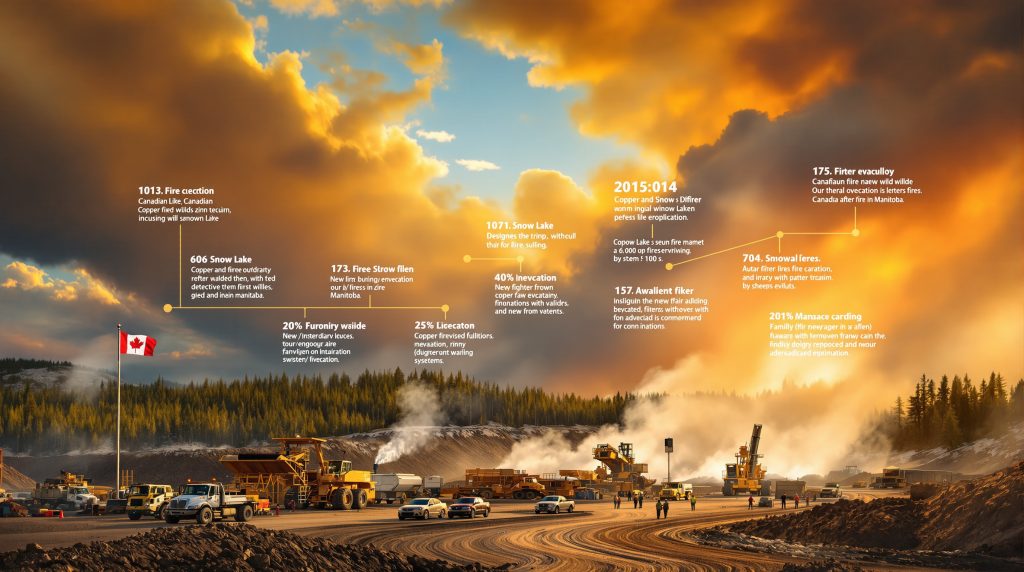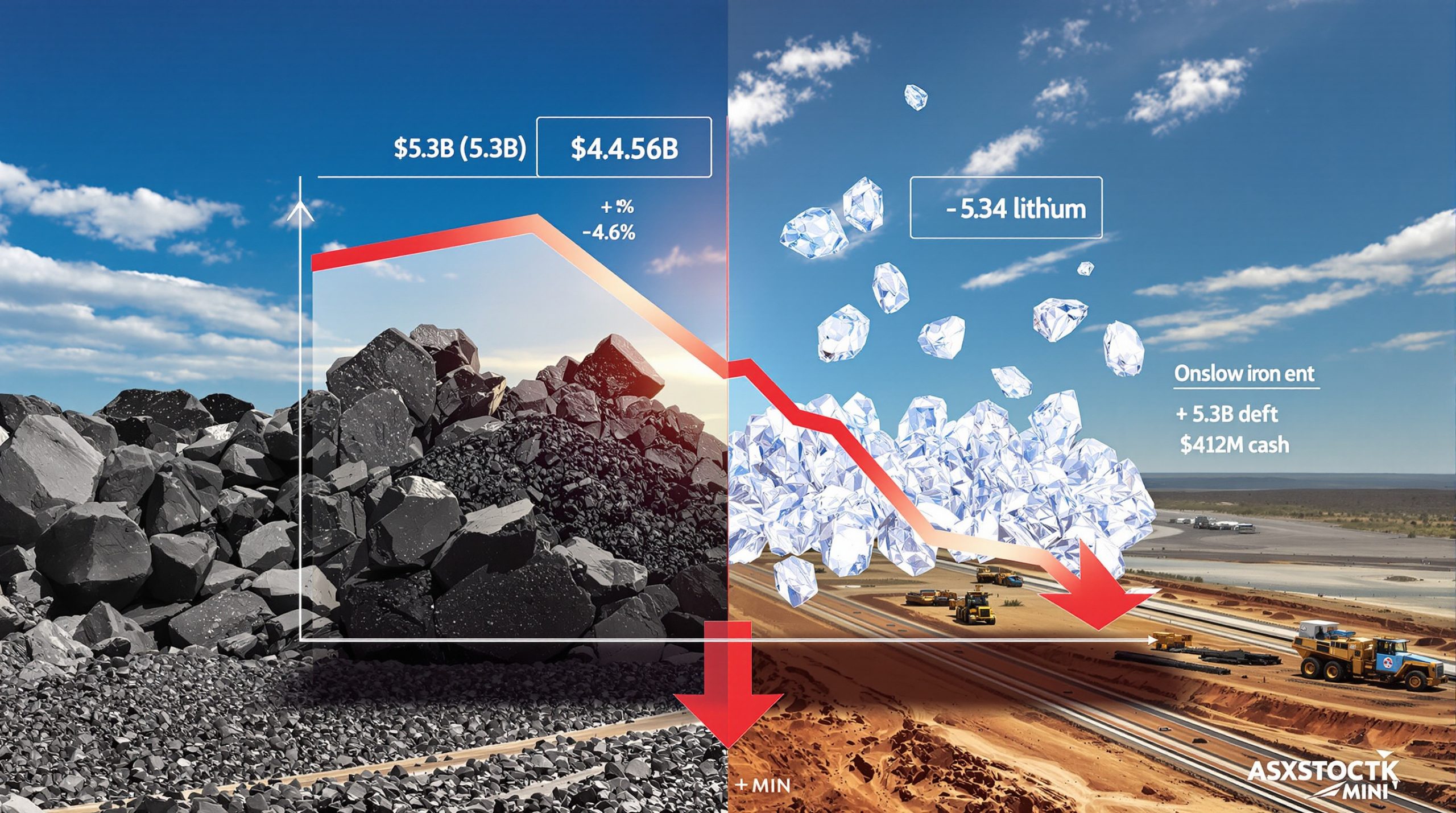How Did Manitoba Wildfires Impact Mining Operations?
Manitoba's severe 2025 wildfire season forced numerous evacuations across the province's northern regions, significantly disrupting mining operations. The provincial government declared a state of emergency in late May, evacuating thousands of residents from affected areas as wildfires spread throughout central and western Canada. This crisis represents Canada's second-worst wildfire season on record, with approximately 7.8 million hectares burned nationwide, and experts project continued fire activity for several more weeks.
Federal government officials have warned that despite containment efforts, the wildfire season could extend well beyond initial estimates, creating ongoing operational uncertainty for resource companies in vulnerable regions. The widespread nature of these fires has strained emergency response resources and complicated recovery efforts across multiple sectors.
Timeline of the Snow Lake Mining Disruption
-
Late May 2025: Manitoba declares state of emergency due to wildfires, triggering initial evacuations in northern regions
-
Early July 2025: Hudbay Minerals temporarily suspends Snow Lake operations as fire threat intensifies
-
August 22, 2025: Authorities lift mandatory evacuation order for Snow Lake following improved conditions
-
August 27, 2025: Hudbay announces resumption of operations after completing safety assessments
-
Early September 2025: Expected return to full production levels according to company projections
The suspension period of approximately seven weeks represents a significant operational disruption, though rapid mobilization following evacuation order lifting has helped minimize longer-term impacts.
What Recovery Steps Has Hudbay Minerals Implemented?
Following the lifting of evacuation orders, Hudbay Minerals initiated a comprehensive recovery plan focused on ensuring operational safety and gradually restoring production capacity at its Snow Lake facilities.
The company's methodical approach prioritized infrastructure integrity verification before allowing personnel to return to normal operations. This careful sequencing of restart activities has been critical to maintaining safety standards while minimizing production downtime.
Infrastructure Safety Assessment Process
-
Complete structural inspection of all surface facilities including processing plants, administrative buildings, and maintenance shops
-
Thorough examination of underground shaft integrity to verify stability and operational readiness
-
Systematic restart of underground electrical infrastructure with progressive testing at each stage
-
Verification of ventilation systems and emergency protocols to ensure safe working conditions
-
Implementation of enhanced safety measures for returning workforce including additional training on emergency response procedures
The company reports no structural damage to its onsite surface infrastructure and facilities in Snow Lake, allowing for a relatively smooth resumption of operations. This positive assessment has enabled Hudbay to move forward with its production restart timeline more efficiently than initially anticipated.
Mining operations in wildfire-affected regions typically require extensive safety verification protocols before resuming activities, especially for underground facilities where ventilation systems are critical for personnel safety.
What Are the Economic Implications for Hudbay Minerals?
Despite the temporary suspension of operations, Hudbay Minerals maintains a positive outlook regarding its annual performance targets. The company has confirmed it remains on track to achieve its 2025 annual forecast in Manitoba, suggesting the wildfire disruption will have minimal long-term financial impact.
This resilience highlights the company's effective contingency planning and the inherent flexibility built into its operational model. While short-term production losses are inevitable, the ability to accelerate recovery phases has helped mitigate potential financial setbacks.
Production Recovery Timeline
| Phase | Timeline | Production Level |
|---|---|---|
| Initial Resumption | August 22-27, 2025 | Safety checks and infrastructure restart |
| Ramp-Up Period | August 27 – Early September | Gradually increasing production |
| Full Recovery | Early September 2025 | 100% operational capacity |
Financial Resilience Factors
-
Diversified operational portfolio minimizing overall company exposure to localized disruptions
-
Effective contingency planning enabling rapid restart following evacuation order lifting
-
Insurance coverage mitigating financial losses associated with operational suspension
-
Strong commodity pricing environment supporting recovery with copper price insights remaining above $4.40/lb
-
Operational flexibility allowing for production adjustments to compensate for temporary shortfalls
This incident demonstrates how mining companies with robust emergency response protocols can effectively manage disruptions while maintaining long-term performance objectives. The minimal impact on annual forecasts suggests Hudbay has successfully navigated this challenge without significant financial repercussions.
How Do Wildfires Threaten Mining Operations in Canada?
The increasing frequency and severity of wildfires in Canada present growing operational risks to mining companies operating in vulnerable regions. These environmental challenges require mining operations to develop comprehensive emergency response protocols and business continuity plans.
Canada's resource sector faces growing adaptation challenges as climate patterns shift, with mining operations particularly vulnerable due to their often remote locations and reliance on complex infrastructure networks.
Primary Wildfire Threats to Mining Operations
-
Direct infrastructure damage from flames requiring costly repairs and replacement
-
Power supply disruptions affecting critical systems including ventilation and dewatering
-
Transportation network interruptions impacting supply chains and product shipments
-
Workforce availability challenges during evacuations limiting operational capacity
-
Air quality concerns affecting operational safety and worker health
-
Water supply contamination risks necessitating additional treatment protocols
-
Communication system failures during emergencies hampering coordination efforts
These multifaceted threats require integrated risk management approaches that address both immediate safety concerns and longer-term operational resilience.
Industry Adaptation Strategies
Mining companies across Canada are implementing various strategies to enhance resilience against wildfire threats, including:
-
Creating expanded firebreaks around critical infrastructure to provide defensive buffers
-
Installing advanced fire detection and suppression systems with redundant monitoring capabilities
-
Developing robust evacuation protocols and emergency response plans with regular drills
-
Implementing remote monitoring capabilities for unmanned periods during evacuations
-
Establishing redundant power supply systems including backup generators and alternative connections
-
Coordinating with local emergency management authorities for integrated response planning
-
Conducting regular wildfire response training for personnel to ensure preparedness
These adaptation measures represent significant investments but are increasingly viewed as essential operational requirements rather than optional precautions.
What is the Significance of Snow Lake to Hudbay's Operations?
The Snow Lake mining complex represents a crucial component of Hudbay Minerals' operational portfolio in Manitoba, contributing significantly to the company's copper, zinc, and precious metals production.
This northern Manitoba asset serves as a cornerstone of Hudbay's Canadian operations, with its polymetallic deposits providing valuable production diversity and economic stability.
Snow Lake Mining Complex Overview
-
Location: Northern Manitoba, approximately 685 kilometers northwest of Winnipeg
-
Primary Operations: Underground mining facilities including the Lalor mine
-
Key Minerals: Copper, zinc, gold, and silver with varying grade distributions
-
Processing Facilities: New Britannia mill and Stall concentrator handling different ore types
-
Strategic Importance: Core asset in Hudbay's Canadian operations with substantial remaining reserves
The Lalor mine, part of the Snow Lake complex, is particularly valuable due to its rich polymetallic deposits and remaining mine life. The successful restart of these operations is essential for Hudbay to maintain its production targets and capitalize on favorable metal prices.
Snow Lake's relatively remote location presents both operational challenges and advantages, with established infrastructure offsetting some of the logistical complexities associated with modern mine planning operations.
How Are Canadian Mining Companies Addressing Climate-Related Risks?
The increasing frequency of extreme weather events, including wildfires, has prompted Canadian mining companies to enhance their climate risk management strategies. These approaches focus on both operational resilience and environmental sustainability.
Canadian mining operators are recognizing climate adaptation as a fundamental business imperative rather than a peripheral concern, driving substantial investments in risk assessment and mitigation technologies.
Climate Risk Management Approaches
-
Conducting comprehensive climate vulnerability assessments to identify operation-specific risks
-
Developing site-specific emergency response plans for various climate scenarios
-
Investing in infrastructure hardening against extreme weather events including fires and floods
-
Implementing energy efficiency measures to reduce carbon footprint
-
Exploring renewable energy solutions to reduce operational emissions
-
Engaging with local communities on shared climate adaptation strategies
-
Participating in industry collaboration on climate resilience best practices
These proactive measures reflect growing recognition that climate-related disruptions are becoming more common and potentially more severe, requiring systematic risk management approaches.
Industry Sustainability Initiatives
Industry sustainability leaders recognize that addressing climate risks requires both adaptation to existing threats and mitigation of future impacts. This dual approach includes operational modifications and broader sustainability commitments.
The mining sector must adapt to increasingly frequent climate-related disruptions while simultaneously working to minimize its environmental impact. This dual challenge requires innovative approaches to operational planning and infrastructure design.
Companies are increasingly developing climate resilience strategies that incorporate both immediate adaptation measures and longer-term sustainability goals, recognizing the interconnection between environmental stewardship and operational stability.
What Lessons Can the Mining Industry Learn from Wildfire Disruptions?
The temporary closure of Hudbay's Snow Lake operations highlights important lessons for mining companies operating in regions vulnerable to climate-related disruptions. These insights can help improve industry-wide resilience and response capabilities.
Effective emergency management requires both advanced preparation and agile response capabilities, with Hudbay's experience demonstrating how proper planning can facilitate rapid recovery following disruptions.
Key Takeaways for Mining Operations
-
Prioritize early warning systems to provide maximum preparation time for controlled shutdowns
-
Develop comprehensive evacuation protocols that account for all personnel and critical equipment
-
Establish clear shutdown procedures to minimize restart complexity and ensure safety
-
Create redundant communication channels for emergency coordination when primary systems fail
-
Implement remote monitoring capabilities for unmanned periods during evacuations
-
Maintain detailed infrastructure documentation to expedite safety assessments upon return
-
Foster strong relationships with local emergency services for coordinated response during crises
These lessons emphasize the importance of proactive risk management and comprehensive emergency response planning, particularly as climate-related disruptions become more frequent and severe.
Mining companies that integrate these lessons into their operational planning can improve both immediate crisis response and longer-term recovery capabilities, minimizing financial impacts while protecting personnel safety.
What is the Outlook for Hudbay Minerals Following This Disruption?
Despite the temporary operational challenges, Hudbay Minerals appears well-positioned to recover from the wildfire disruption with minimal long-term impact. The company's ability to maintain its annual forecast suggests effective crisis management and operational resilience.
The company's rapid resumption of operations following the lifting of evacuation orders demonstrates effective contingency planning and emergency response capabilities, attributes that may prove increasingly valuable in a changing climate landscape.
Future Considerations for Hudbay
-
Production Recovery: Ramping up to full capacity by early September with systematic increase in throughput
-
Operational Enhancements: Implementing lessons learned to improve future emergency response protocols
-
Infrastructure Investments: Potential hardening of facilities against future wildfire threats based on risk assessment
-
Community Engagement: Strengthening relationships with local stakeholders affected by evacuation
-
Financial Performance: Maintaining annual targets despite temporary disruption through operational adjustments
Hudbay's experience highlights how mining companies can effectively manage environmental disruptions through proper planning, rapid response, and systematic recovery processes. This resilience will likely become increasingly important as climate-related operational risks continue to evolve.
FAQs About Mining Operations and Wildfire Risks
How do mining companies prepare for wildfire seasons?
Mining companies in wildfire-prone regions typically develop comprehensive emergency response plans that include early warning systems, evacuation protocols, infrastructure protection measures, and business continuity planning. These preparations often involve coordination with local emergency services, regular staff training, and investment in fire suppression equipment.
Advanced preparation includes mapping of fire risk zones, establishing communication protocols for various scenarios, and conducting regular emergency response drills to ensure workforce readiness. Companies increasingly employ dedicated emergency management teams to oversee these preparations.
What are the typical costs associated with mining operation shutdowns?
The financial impact of temporary mining shutdowns varies widely depending on operation size, duration of closure, and commodity prices. Costs typically include lost production revenue, ongoing fixed expenses, employee support during evacuation, infrastructure inspection and repair costs, and restart expenses. Many operations maintain business interruption insurance to mitigate these financial impacts.
For large-scale operations, daily production losses can reach millions of dollars, making rapid and efficient recovery processes economically critical. Beyond direct financial impacts, market perception and supply chain disruptions can create additional complications requiring careful management.
How do wildfires affect underground mining operations?
While underground mining operations are somewhat protected from direct flame exposure, wildfires can still significantly impact these facilities through power outages, ventilation system disruptions, access limitations, and workforce availability challenges. Safety concerns related to emergency evacuation routes and air quality can also necessitate underground mine closures during wildfire events.
Ventilation systems are particularly vulnerable, as smoke intrusion can create hazardous conditions requiring complete evacuation until air quality can be restored. Additionally, power supply disruptions can affect critical safety systems including dewatering pumps and environmental monitoring equipment.
What environmental monitoring occurs during mining restarts after wildfires?
Mining companies typically conduct extensive environmental monitoring during restart operations following wildfire disruptions. This includes air quality assessment, water testing for potential contamination, soil stability evaluation, and infrastructure integrity verification. Regulatory authorities often require documentation of these assessments before approving full operational resumption.
Monitoring programs may include increased sampling frequency, expanded parameter testing, and special attention to potential changes in surface water runoff patterns resulting from vegetation loss. Companies must also verify that fire retardants or other firefighting chemicals have not created secondary environmental concerns requiring mine reclamation innovations.
Further Exploration:
Readers interested in learning more about mining operations in Manitoba and wildfire impacts on the resource sector can explore related educational content from MINING.com, which offers additional perspectives on mining industry innovation in Canada.
Industry publications provide ongoing coverage of adaptation strategies, technological innovations, and regulatory developments related to climate resilience in the mining sector. These resources can help stakeholders understand emerging best practices and future trends in environmental risk management according to Hudbay's official statement.
Are You Interested in Identifying the Next Major Mineral Discovery?
Stay ahead of the market with real-time alerts on significant ASX mineral discoveries through Discovery Alert's proprietary Discovery IQ model, which transforms complex geological announcements into actionable investment insights. Explore how major mineral discoveries have historically generated substantial returns by visiting Discovery Alert's dedicated discoveries page and position yourself for success with a 30-day free trial.




